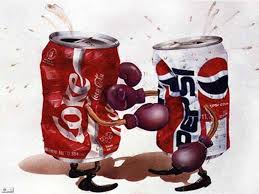But his masterstroke was the all-out marketing blitz against Coca-Cola, long the global market leader in non-alcoholic beverages. The two firms had competed for decades, but they mostly fought low-grade battles. Mr Kendall changed that, by forcing both companies into an advertising arms race. In 1975 Coca-Cola spent around $25m on advertising and PepsiCo some $18m. By 1985 those figures had shot up to $72m and $57m, respectively. In 1995 Pepsi outspent Coke by $112m to $82m.
但他的絕招是針對可口可樂發動營銷閃電戰,后者長期以來一直是無酒精飲料市場的領導者。這兩家公司已經競爭了幾十年,但大多是低級別的較量。肯德爾通過迫使兩家公司進入廣告軍備競賽,扭轉了這一局面。1975年,可口可樂公司花費約2500萬美元用于廣告宣傳,百事可樂花掉了大約1800萬美元。到了1985年,兩家廣告費各自飆升至7200萬美元和5700萬美元。1995年,百事可樂的廣告費為1.12億美元,超過了可口可樂的8200萬美元。
This was a risky gambit for both cola rivals. But it paid off in two ways. First, it helped fizzy drinks win a greater “share of throat” (a term coined by Roberto Goizueta, a former boss of Coca-Cola, who died in 1997). They went from 12.4% of American beverage consumption in 1970 to 22.4% in 1985. And though Coca-Cola maintained its lead in that period, with over a third of the market, PepsiCo’s share shot up from 20% to a peak of over 30% in the 1990s. Last year carbonated-drinks sales totalled $77bn in America, and over $312bn globally. Coca- Cola and PepsiCo remain dominant.
這對兩家可樂公司來說都是冒險之舉。但同時也帶來了兩大好處。首先,它幫助汽水飲料贏得了更大的“喉嚨份額”(這是由1997年去世的可口可樂公司前老板羅伯特·戈依蘇埃塔發明的術語)。1970年,汽水飲料占美國飲料銷量的12.4%,而到1985年則上升至22.4%。在20世紀90年代,盡管可口可樂公司以超過三分之一的市場份額保持了當時的領先地位,但百事可樂公司的市場份額從20%驟升至峰值30%以上。去年,碳酸飲料在美國的銷售額達到770億美元,全球總銷售額達到3120億美元。可口可樂和百事可樂依舊占主導地位。

The second way that the cola wars benefited both companies was by turning them into “the world’s best marketers”, observes Kaumil Gajrawala of Credit Suisse, a bank. Today a decades-long obsession with cutprice volume growth has been replaced by a focus on revenues and profits.
瑞士信貸銀行的考米爾·格拉瓦拉認為,可樂大戰使兩家公司受益的第二個方面是,它令兩家公司都變成“世界最好的營銷企業”。如今,數十年來對降價銷量增長的癡迷已被對收入和利潤的關注所取代。
PepsiCo in particular has relinquished some of the soft-drinks market, where its share has fallen back down to a quarter (see chart 1). But its marketing magic continues to sparkle, even if it is deployed to sell less sugary alternatives such as bottled water, coffee and energy drinks to health-conscious consumers. And over the past 40 years PepsiCo has returned nearly a third more to shareholders than Coca-Cola has.
尤其是百事可樂公司已經放棄了部分軟飲料市場,其在該市場的份額已回落至四分之一。即使百事公司只面向注重健康的消費者銷售低糖替代品,如瓶裝水、咖啡和能量飲料,但它的銷售魔力仍舊閃耀。在過去的40年里,百事公司給予股東的回報比可口可樂多出近三分之一。
In many industries a cosy duopoly retards innovation and harms consumers. The happy outcome of the cola wars has been the exact opposite. As Mr Kendall himself observed, “If there wasn’t a Coca- Cola, we would have had to invent one, and they would have had to invent Pepsi.”
在許多產業中,密切的雙寡頭壟斷阻礙了創新,并損害了消費者。而可樂大戰的結果則恰好相反。正如肯德爾先生自己所觀察到的那樣:“如果沒有可口可樂公司,我們也要創造一個,而可口可樂也必須創造出百事可樂公司。”
譯文由可可原創,僅供學習交流使用,未經許可請勿轉載。












